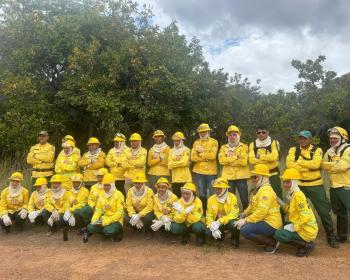In the Fall of 1981, FUNAI (Brazil's National Indian Foundation), in an official resolution [portaria], proposed the establishment of three Indian reserves in the Guaporé Valley. These reserves - of 29,580; 243,000; and 68,000 hectares - were to be set aside for nine local groups of Nambiquara Indians. On 22 January 1982 Coronel Paulo Moreira Leal announced that the internal recommendations to demarcate these areas had been suspended and that the situation was under review.
The Nambiquara, who numbered some 10,000 at the turn of this century, now number only about 600. Considerable attention has been focused on their situation during the last two years since it was announced that the Brazilian government, with World Bank financing, would reroute and pave a road through the Guaporé Valley, the traditional lands of these Indians. The recommendations of anthropologists, combined with international pressure, convinced Bank officials that loans for road building and associated development projects should be conditional upon adequate safeguards for the Indians living in the area. The three proposed reserves were intended to be the first step in the provision of such safeguards.
Officials from the state of Mato Grosso, where the Guaporé Valley is located, were upset with the size and location of the proposed reserves. In addition, they thought FUNAI officials should have consulted with them before proposing specific reserves. On 31 December 1981, the Brazilian press reported that Domingos Savio Brandao Lima, the Secretary of Interior and Chief Justice of Mato Grosso, had sent telegrams to the head of FUNAI and the national Secretary of the Interior in Brasília. In these telegrams he threatened "to mobilize national opinion to combat this affront to our national territory and progress." In his statements Brandao Lima also alleged that only 136 Indians would benefit from these reserves which the press implied totalled some 2 million hectares. O Globo deviated from the standard press release by stating that Brandao Lima had travelled throughout Brazil last year condemning FUNAI.
These same officials, however, appear to have confused the facts of the case as well as the role of the state of Mato Grosso in the determination of Indian lands under Brazilian law. Instead of 136 Indians to be benefited as is suggested by Brandao Lima, about 380 would benefit from the proposed demarcation. To date, there are four - not nine - reserves for the Nambiquara in the Guaporé Valley, and they contain in total only 57,883 hectares (for more information see CSN 4/4), far short of the 2 million hectares claimed by Mato Grosso's Secretary of the Interior.
The Governor of Mato Grosso claimed that there are 250 productive properties in the area. However, reliable sources indicate that perhaps only a score or so of properties exist in the entire valley. The head of FUNAI's Fifth Delegacy in Cuiabá, Darcy Alvares da Cunha, indicated that only 2 or 3 ranches with improvements would be affected by the proposed reserves.
The proposed reserves would not only have benefited the Indians of the area. As areas B and C were proposed they would have protected the watershed of the Guapore River. Most of the lands covered by these areas are forested escarpments and demarcating the land would ensure that the areas would not be cleared and, eventually, eroded.
The protected areas also contain caves that are sacred sites for the Nambiquara. In addition, some of the oldest archeological sites in lowland South America would have been protected within these reserves.
In Brazil the constitutional provision is the highest and most binding form of legislation. According to the constitution, Indians are guaranteed the inalienability of their lands. This territory is to be the permanent possession of Indian peoples. The amendment maintains that Indians have exclusive use rights over the natural resources within their lands. Demarcation is the mechanism for guaranteeing the protection of that land. However, the right to the land precedes the obligation of the government to demarcate it. Thus, FUNAI is merely carrying out its duties under the constitution, and the state of Mato Grosso should not be able to interfere with that duty.
This particular case, important in and of itself for the Guaporé Valley Nambiquara, raises a number of questions concerning Indians in Mato Grosso and Rondônia. One of the stipulations insisted upon by the World Bank for partial funding of the Polonoroeste Project - road building, land titling and rural development - for these states was that there would be adequate safeguards for the indigenous groups in the area. The immediate concerns of Bank officials were land and health, but the ability of local officials to interfere with such safeguards suggests that it is doubtful that Brazil, without pressure from the outside, will insure adequate safeguards for Indians.
Whatever happens to the Indians of the Guaporé Valley, they constitute only four percent of the indigenous population in the Polonoroeste Project area. A number of other groups also need to have their lands identified and demarcated. In addition to lands, uncontacted or recently contacted groups will need medical assistance. Illegal roads need to be closed and settlers living on Indian land need to be evicted. Illegal mining operations should be closed. How many of these things can be done under the present conditions where FUNAI policy can be so easily altered?
Finally, for some years now, officials in Brazil have suggested that it might be more appropriate for FUNAI to be organized and directed on a state by state basis. Anthropologists and indianists have pointed out that this would allow landed, local interests undue influence on Indian policy. The case of the proposed reserves for the Nambiquara exemplifies why such a policy should not come to pass.
YANOMAMO RESERVE
On 22 January 1982, Coronel Paulo Moreira Leal, the president of FUNAI (Brazil's National Indian Organization) informed the press that within one week a decision regarding Yanomamo lands would be made public. Leal was to indicate whether a continuous park would be created for the Yanomamo, whether individual reserves would be granted for each group or whether the Yanomamo would even be granted any land.
Indian organizations, as well as support groups throughout the world, have insisted upon a continuous reserve for the Yanomamo. Such a reserve would be easier to defend from incursion and would allow for interaction between Yanomamo groups to continue. Finally, such a reserve would protect a unique ecological area in the Amazon Basin.
Further details on the situation of the Yanomamo will be presented in the next issue of CSQ.
Article copyright Cultural Survival, Inc.



